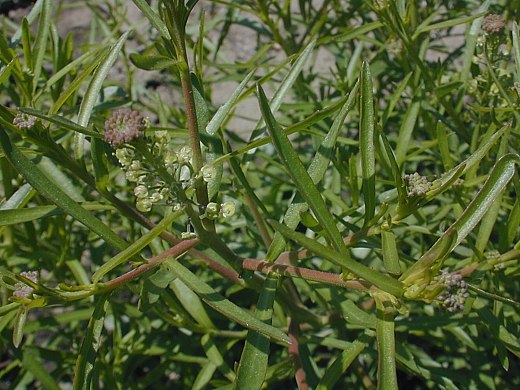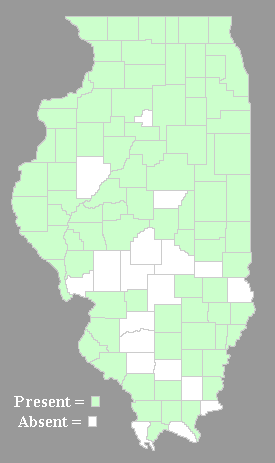Description: This plant is usually a winter annual; less often, it is a summer annual or biennial. It overwinters as a low rosette of basal leaves up to 6" across. Individual basal leaves are up to 3" long and ¾" across; they are variably pinnatifid and hairless to mostly hairless. During the spring and early summer, this plant develops branching stems with alternate leaves. A robust specimen is about 1½' tall, 2' across, and rather bushy in appearance; however, specimens at barren sites are typically less branched and smaller in size. The stems are light green to reddish green and glabrous (or nearly so). The alternate leaves are up to 2½" long and ¼" across; they are medium green, linear to linear-oblong in shape, smooth or slightly dentate along their margins, glabrous, and sessile. Unlike the basal leaves, none (or very few) of the alternate leaves are pinnatifid.

The upper stems
terminate in elongated racemes that have abundant flower buds, flowers,
and seedpods (silicles). These racemes eventually become about 3-4"
long. The flower buds at the apex of each raceme are often slightly
pink or red, particularly in bright sunlight. The greenish flowers are
about 1/8" (3 mm.) long and inconspicuous. Each of these flowers has 4
tiny
white petals (or none), 4 linear green sepals, a pistil with a single
style, and 2 or more stamens. The petals, if present, are smaller than
the sepals. The slender pedicel of each flower is about ¼" long. The
blooming period usually occurs from late spring to mid-summer, although
some plants will bloom later in the year. Each flower is replaced by an
orbicular 2-celled seedpod (or silicle) about 1/6" (4 mm.) long and
across; this seedpod is flattened and it has a tiny notch at its apex.
Each cell of this seedpod contains a single seed. The seedpods are
light enough be blown about by the wind, thereby distributing the
seeds. The root system consists of a taproot.
Cultivation:
This weed prefers full sun, mesic to dry conditions, and fertile loamy
soil, although it also adapts readily to rocky or sandy soil. The size
of individual plants is strongly affected by soil fertility and
moisture conditions.

Range & Habitat:
Green-Flowered Peppergrass is occasional to locally common in central
and northern Illinois, while in southern Illinois it is less common. It
was introduced accidentally into North America from Eurasia. Habitats
include degraded prairies and glades, cultivated and abandoned fields,
areas along railroads and roadways, vacant lots, and waste areas. This
plant typically occurs in disturbed habitats where the topsoil is
exposed. It does not invade high quality natural habitats to any
significant degree.
Faunal Associations:
Generally, the flowers of Lepidium spp.
(peppergrasses) attract small bees (Halictid, masked, little carpenter
bees) and various flies (especially Syrphid flies). These insects seek
nectar and pollen from the flowers. The caterpillars of the butterflies
Anthocharis midea (Falcate Orangetip) and Pontia
protodice (Checkered White) occasionally feed on
peppergrasses, as do the caterpillars of Eustixia pupula
(Snout Moth sp.). The foliage of this group of plants has a peppery
taste from mustard oils in varying degrees, which may provide some
protection from mammalian herbivores.
Photograph Location:
A cultivated field near Champaign, Illinois.
Comments:
This is one of many members of the Mustard family that has been
introduced from Eurasia. In Illinois, Green-Flowered Peppergrass is
primarily an agricultural weed. Distinguishing this species from other
Lepidium spp. (peppergrasses) can be difficult. Key
characteristics to look for include the following: 1) The petals of the
flowers are shorter than the sepals and inconspicuous, or they are
absent altogether, 2) the flower buds are often slightly pink or red in
bright sunlight, 3) the alternate leaves of the stems are rarely
pinnatifid, 4) the foliage is hairless, or nearly so, and 5) the
crushed foliage lacks a foul odor. The only other species in this genus
that has petals smaller than the sepals (or that are absent altogether)
is Lepidium ruderale (Stinking Peppergrass). This
latter species is rarely seen in Illinois. Unlike Green-Flowered
Peppergrass, it has pinnatifid alternate leaves and foul-smelling
foliage. Other members of the Mustard family can be distinguished from
the peppergrasses by the shapes of their seedpods or their yellow
flowers.